Midjourney & AI Art Generators for Podcasters: Here There Be Dragons
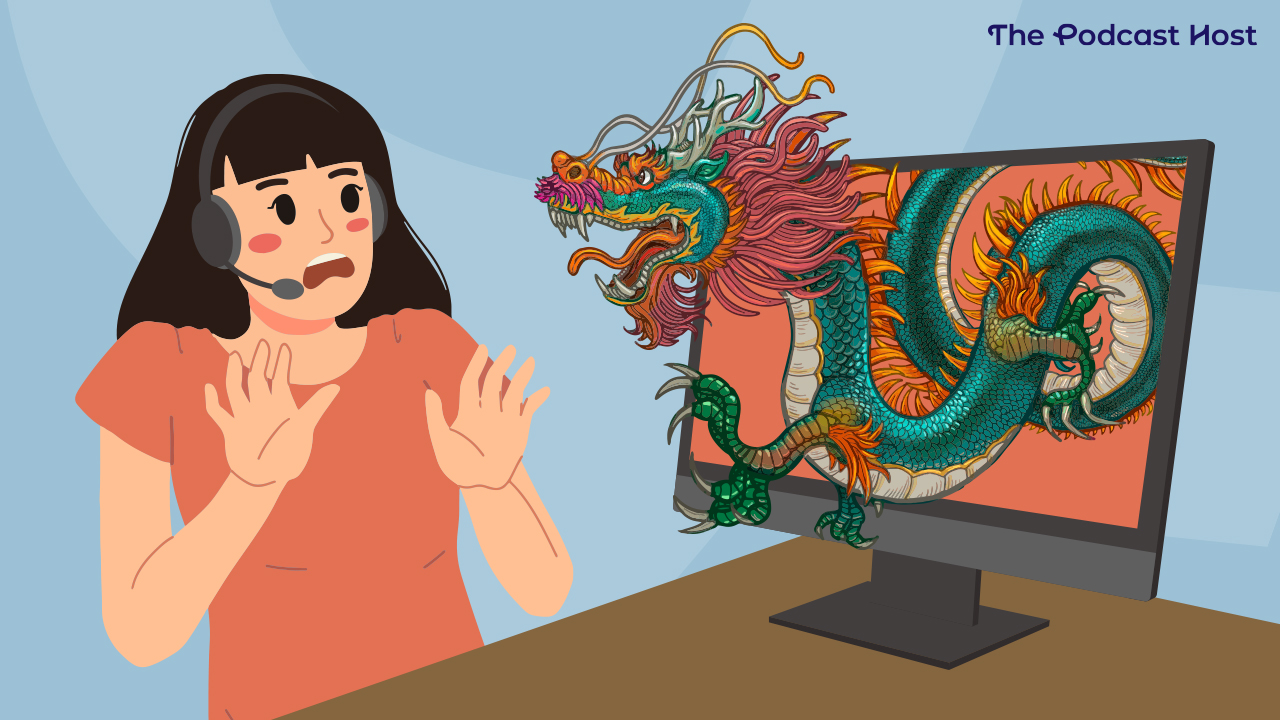
Imagine you want a really beautiful avatar picture for social media. You think, “Hey, I’ll just use an AI art generator, and it will make me look like a supermodel!”
You might wanna slow your roll there, Picasso. Your avatar could end up having one eye and nine fingers.
In the last year, AI image generators have become all the rage in digital content creation. If you’re here, you’re probably curious and want to learn more. This article will show you how to use AI art generators most effectively for your podcast. I’ll begin by walking you through Midjourney. Then, we’ll look at how to use prompts to generate useful images. Finally, we’ll look at some of the limitations of these tools and how to combine them with human tools.
Midjourney: An Accessible Example of AI Art Generators
Midjourney is one of the most accessible AI art generators, setting standards for many other apps. Like DALL-E or Stable Diffusion, Midjourney is a program that generates images based on text descriptions. None of these AI podcasting tools that make art are identical, but they work similarly.
Midjourney Founder David Holz says it’s intended for professional artists to quickly make prototypes for clients before making a complete product. In other words, it’s meant to be the “mid-journey” stage between the client’s idea and the designer’s final product.
How Does Midjourney Work?
Midjourney is available via a Discord server. There’s a bit of a learning curve, but Discord is similar to most chatrooms or Slack. If you’ve ever used Internet Relay Chat, Discord will look familiar.
First, you enter the command “/imagine,” followed by a text description of what you want the art to look like. The AI generates an image based on that description. How closely that image matches what you had in mind depends on:
- The language in the prompt (Midjourney takes your prompts literally)
- The AI art generator’s training (the images in its database)
- How you vary the output (Once Midjourney generates an image, you can ask for variations or upgrades of those images.)
Let’s look at how it works, step by step.
I tried to make an image for Podcraft. I asked for “a logo for a podcast about the craft of making a podcast.” Here’s what Midjourney imagined.
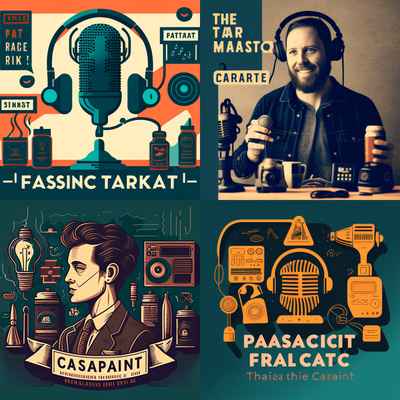
These four look cool. But the colors are very different from our brand palette. Plus, I’ll have to fix the text (or change our podcast’s name to something like Fassinc Tarkat).
If I could break these images into layers, I could adjust the colors, font, and text using image editing software. So, I asked for “a logo for a podcast about the craft of making a podcast, indigo, cobalt blue, yellow.” I thought that Midjourney would serve me the same images but with the requested color palette. Instead, it gave me a completely different image.
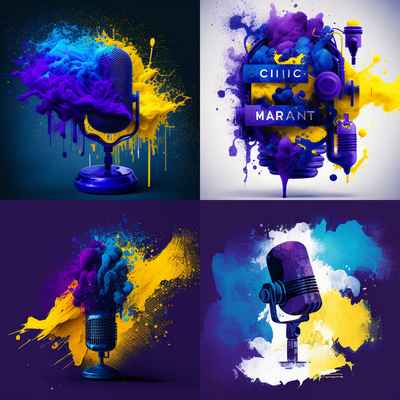
So, yes, I could use Midjourney to make a mockup for a simple logo, but not a finished product. Clearly, I need to prompt Midjourney differently.
Midjourney Prompts to Save Time
Midjourney’s documentation can help you write prompts that generate images closer to what you imagine. When your prompts are focused and specific, you’ll get images that look more like what you want.
A good Midjourney prompt starts with the command “/imagine,” followed by (a description of the image) plus (how the image is made).
The most basic prompt tells Midjourney what to imagine. For example, “/imagine a dragon podcaster.”
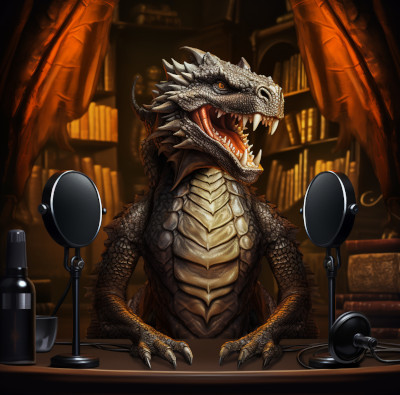
Here, we have a dragon with what looks like two pop filters (maybe he ate his guest?). Midjourney gave me the most obvious and general definition of “dragon” and “podcaster.”
So, we need to add some specifics. Short sentences work better, even if you need more details. Don’t ask for “a warm, cute, and friendly dragon podcaster for a children’s podcast about fairy tales drawn with colored pencils.” Try, “Imagine a friendly dragon podcaster drawn with colored pencils.”
Midjourney can imitate art styles, periods, or specific artists. If you enter the kind of camera used for a photo, Midjourney can simulate it. You can also enter the URL of an image you want Midjourney to emulate.
Let’s say I want an image similar to the painting The Reluctant Dragon by Maxfield Parrish for my podcast art. My prompt would start with the image’s URL, followed by the text description, and any additional parameters.
So, a prompt with “/imagine (url) friendly dragon podcaster painted in the style of Maxfield Parrish” produced this:
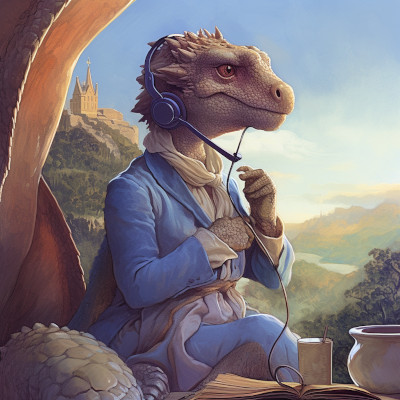
To make the process easier, before you ask Midjourney to imagine your podcast art, sketch your ideas or pick out a color palette. Plan out exactly what you want from the beginning and know how to ask for it. Know the name of the art style and period you want. This way, you’ll quickly get to the image you want.
Pricing for Midjourney
Midjourney offers a discount for purchasing a year’s worth of time in advance. The determining factors are processing speed (whether “fast” or “relaxed”) and the number of jobs you can run at once.
- Basic Plan: For $10 a month or $96/year, you get 3.3 hours a month of “Fast” processing time. You can request three jobs at once and have ten jobs waiting in your queue.
- Standard Plan: For $30 a month ($288/year), you get 15 hours a month of “fast” processing time and unlimited “relaxed” processing time. You can request three concurrent jobs and have ten jobs waiting in the queue.
- Pro Plan: $60 a month (or $576 a year), 30 hours a month of “fast” time, and unlimited “relaxed” processing time. The maximum number of jobs you request at once can be up to 12 fast, three relaxed, and ten waiting in the queue.
- Mega Plan: $120 a month or $1152 per year gets you 60 hours of fast processing time, unlimited relaxed processing time, and the maximum number of jobs you request at once can be up to twelve fast, three relaxed, and ten waiting in the queue.
It’s worth noting that once you create an image with Midjourney, it’s available under General Commercial terms. Midjourney says, “If you have subscribed at any point, you are free to use your images in just about any way you want. However, if you are a company making more than $1,000,000 USD in gross revenue per year, you must purchase the Pro or Mega plan.”
This is great for independent podcasters who might want MidJourney to help them imagine the Mona Lisa riding a bicycle for their podcast logo, website, and merchandise. But, if the Coca-Cola company wanted to fire their art department and hire Midjourney instead, they need to pay the price.
The Limits of AI Art Generators
Remember: Midjourney is intended for the halfway point. AI art generators make images that look beautiful quickly, but they lack the flexibility that full graphic design programs provide.
Let’s say you want to build a logo for your podcast and use that art for your website and associated marketing materials. In that event, as we’ve seen, an AI art generator is not your best friend. The image Midjourney generates is 72 dots per inch. This is fine for digital content but not dense enough for print. The flat image doesn’t have layers you can adjust to re-purpose. And, you saw what Midjourney does with text.
But, with AI-generated art, you have two options.
Work With an Artist
First, you can hire a human designer at a slightly higher cost. A designer can make you multiple versions of the same image, at the dimensions of your choice, in minutes. c7productions on Fiverr is an artist we’ve worked with in the past and recommend. This has the additional advantage of paying a human, as you’d want to be paid for your work, too, right?
The DIY Approach
Alternatively, you can go the DIY route. You can also make your own podcast art. If our comprehensive guide isn’t enough for you, Canva has templates and all the design elements you need to make professional art for your podcast and marketing materials. The blog and tutorials there are particularly helpful. And, Canva also now has Magic Studio, an AI-fueled design interface that works similarly to Midjourney. If you can describe it, Canva can add it to your podcast art.
Shutterstock, too, has podcast art templates, images, and guidance to help you make polished, professional podcast art as individual as you are. Like Canva, Shutterstock integrates AI art generators to help you design anything you can dream up.
Our links to Fiverr and Shutterstock are affiliates. If you purchase something via those links, we may earn a small commission, but you don’t pay anything extra.
Should You Use Midjourney for Your Podcast Art?
In short, AI art generators are fine, even useful, as long as you are aware of their limitations. When you pair these tools with human intelligence, you can get art and branding that attracts new audiences and inspires loyalty in your fans. You might not produce a Picasso in minutes. But you won’t have creepy fingers.
The more you learn how to take care of the details of your podcast, the more you put your unique stamp on that show. Human authenticity is something audiences appreciate; it’s why people want to listen to podcasts.

